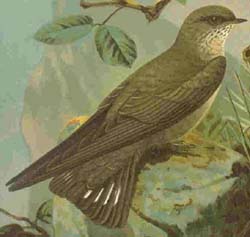|
| Query: bird | Result: 2746th of 32675 | |
Crag Martin (Ptyonoprogne rupestris) - wiki
| Subject: | Crag Martin (Ptyonoprogne rupestris) - wiki
| |

| Resolution: 250x237
File Size: 14446 Bytes
Upload Date: 2007:08:26 20:23:15
|
Crag Martin
From Wikipedia, the free encyclopedia
[Photo] Crag martin from 1905 German enc
The Crag Martin, Ptyonoprogne rupestris, is a small passerine bird in the swallow family. It breeds in the mountains of southern Europe, the Mediterranean and south Asia. Many European birds are resident, but some northern breeders and most Asian birds are migratory. They winter in north Africa or India.
The Crag Martin is 14-15 cm long and somewhat similar in habits and appearance to the other aerial insectivores, such as the related swallows and the unrelated swifts. It has brown upperparts and dusky underparts, and shows white "windows" on the spread tail in flight.
It resembles the Sand Martin, but is larger, darker below, and lacks a breast band. Its flight is fast and agile, and it swoops on the insects on which it feeds while airborne. It has broad pointed wings.
The Crag Martin builds a neat quarter-sphere nest lined with mud collected in its beaks, and lays 3-5 eggs. It normally nests under cliff overhangs in its mountain homes, but will readily adapt to buildings and motorway bridges. It does not normally form large breeding colonies, but is gregarious outside the breeding season.
http://en.wikipedia.org/wiki/Crag_Martin
| The text in this page is based on the copyrighted Wikipedia article shown in above URL. It is used under the GNU Free Documentation License. You may redistribute it, verbatim or modified, providing that you comply with the terms of the GFDL. |
|
Comments |
|---|
| | Guest |
|
| 바위산제비 Ptyonoprogne rupestris ( Eurasian Crag Martin ) |
^o^
Animal Pictures Archive for smart phones
^o^
|
|
|